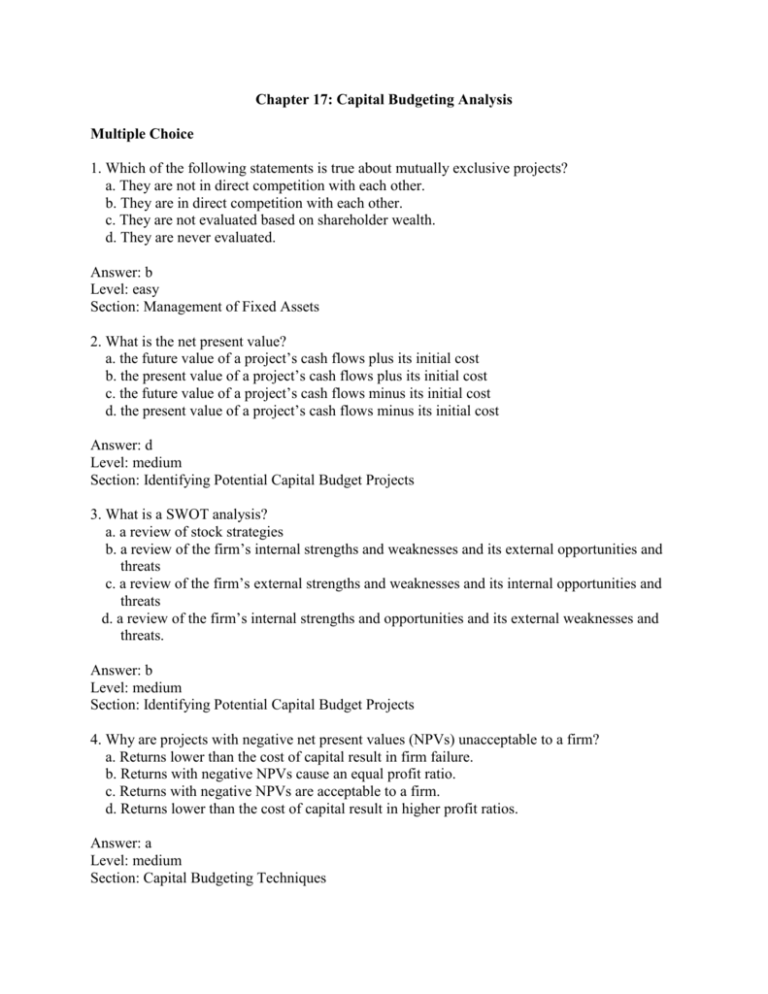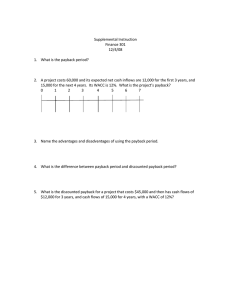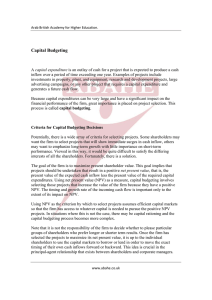Chapter 17: Capital Budgeting Analysis Multiple Choice 1. Which of
advertisement

Chapter 17: Capital Budgeting Analysis Multiple Choice 1. Which of the following statements is true about mutually exclusive projects? a. They are not in direct competition with each other. b. They are in direct competition with each other. c. They are not evaluated based on shareholder wealth. d. They are never evaluated. Answer: b Level: easy Section: Management of Fixed Assets 2. What is the net present value? a. the future value of a project’s cash flows plus its initial cost b. the present value of a project’s cash flows plus its initial cost c. the future value of a project’s cash flows minus its initial cost d. the present value of a project’s cash flows minus its initial cost Answer: d Level: medium Section: Identifying Potential Capital Budget Projects 3. What is a SWOT analysis? a. a review of stock strategies b. a review of the firm’s internal strengths and weaknesses and its external opportunities and threats c. a review of the firm’s external strengths and weaknesses and its internal opportunities and threats d. a review of the firm’s internal strengths and opportunities and its external weaknesses and threats. Answer: b Level: medium Section: Identifying Potential Capital Budget Projects 4. Why are projects with negative net present values (NPVs) unacceptable to a firm? a. Returns lower than the cost of capital result in firm failure. b. Returns with negative NPVs cause an equal profit ratio. c. Returns with negative NPVs are acceptable to a firm. d. Returns lower than the cost of capital result in higher profit ratios. Answer: a Level: medium Section: Capital Budgeting Techniques 5. The NPV measures the ______ change in shareholder wealth that arises from undertaking a project. a. consistent b. dollar c. annual d. semi-annual Answer: b Level: easy Section: Conflicts Between Discounted Cash Flow Methods 6. The Internal Rate of Return is defined as a. the discount rate which causes the payback to equal one year. b. the discount rate which causes the NPV to equal zero. c. the ROE when the NPV equals 0. d. the ROE associated with project maximization. Answer: b Level: easy Section: Internal Rate of Return 7. What are the two drawbacks associated with the payback period? a. The time value of money is ignored. It ignores cash flows beyond the payback period. b. The time value of money is considered. It ignores cash flows beyond the payback period. c. The time value of money is considered. It includes cash flows beyond the payback period. d. The time value of money is ignored. It includes cash flows beyond the payback period. Answer: a Level: difficult Section: Payback Period 8. Each of the following techniques use discounted cash flows to incorporate the time value of money into their analysis except a. net present value (NPV) b. payback method c. internal rate of return (IRR) d. modified internal rate of return Answer: b Level: easy Section: Differences Between Theory and Practice 9. Which of the following cash flows should not be considered relevant in calculating project cash flows? a. opportunity costs b. any effects caused by cannibalization c. investments in net working capital as a result of making the investment d. sunk costs Answer: d Level: difficult Section: Estimating Project Cash Flows 10. _____________________ measures the dollar change in shareholder wealth that arises from undertaking a project. a. Net present value b. IRR c. Profitability index d. Modified IRR Answer: a Level: medium Section: Conflicts Between Discounted Cash Flow Techniques 11. In relation to cash flow projections, the format of the statement of cash flows is beneficial because it identifies the __________________________ of a capital budgeting project. a. unified cash flows b. individual cash flows c. periodic cash flows d. multiple cash flows Answer: c Level: medium Section: Approaches to Estimating Project Cash Flows 12. Which of the following is not a characteristic of an effective control system? a. It pinpoints personal responsibility. b. Top management lacks the ability to evaluate the business unit. c. It controls intra-firm agency problems. d. It records the names of the persons who make estimates. Answer: b Level: difficult Section: Keeping Managers Honest 13. What occurs in the fifth stage of the capital budgeting process? a. Financial analysts refer the books over to the CPA. b. Financial analysts conduct a SWOT analysis. c. Financial analysts close out the books and sell the business. d. Financial analysts track both the spending and the results of the firm’s current capital budgeting projects. Answer: d Level: medium Section: Keeping Managers Honest 14. A manager can presume that the project will enhance shareholder wealth only if its NPV based on the risk-adjusted rate is a. positive. b. negative. c. zero. d. equal. Answer: a Level: easy Section: Risk-Related Considerations 15. What is a way to operationalize shareholder wealth maximization? a. Identify and select projects that are expected to have negative net future values. b. Identify and select projects that are expected to have positive net future values. c. Identify and select projects that are expected to have positive net present values. d. Identify and select projects that are not expected to have positive net present values. Answer: c Level: difficult Section: Applying Finance to Institutions and Markets











